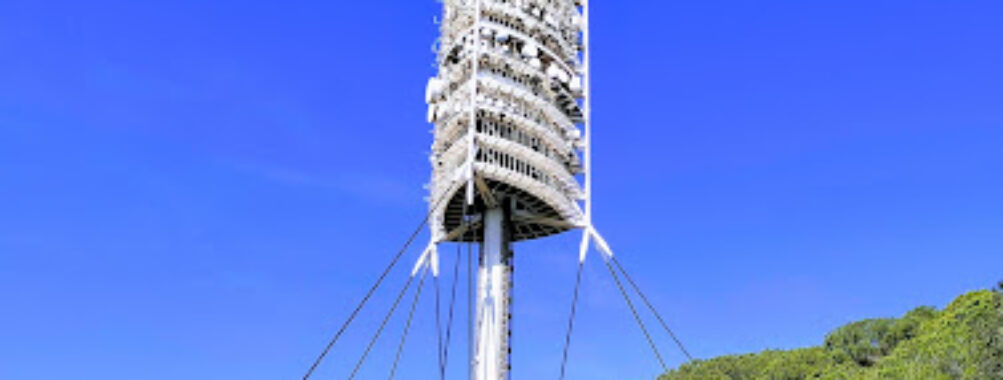
Torre de Collserola
Table of Contents
Imagine climbing above all the city noise, the crowds, and even the rooftops of Barcelona to perch inside a futuristic pod, gazing in every direction, the world stretched out beneath you. That’s exactly what it feels like to visit Torre de Collserola, the city’s sleek telecommunications tower designed by architect Norman Foster. The tower’s unique, somewhat space-age design punctuates the skyline on Tibidabo mountain, serving both as the highest viewpoint in the area and a vital cog in Catalonia’s broadcasting network.
Let’s be honest—most people think of Barcelona and immediately go to the beaches, Sagrada Familia, or the old Gothic alleys filled with tapas bars. Few realize that on the city’s outskirts, rising from the woody Collserola Park, sits this ultra-modern structure that does something different; it connects Barcelona with the world through radio, satellite, and TV transmissions, all while offering visitors one of the most exhilarating viewpoints anywhere in Spain.
Torre de Collserola skyrocketed into the cityscape in 1992, built for the Olympic Games—a moment when the whole world tuned in to see Barcelona shine. This is not just a tower to beam out television and radio signals; it’s an architectural statement. Its glass and steel pod, dangling almost 600 meters above sea level, provides an epic 360-degree panorama that sweeps from the Mediterranean Sea, over the palaces of the city, across Catalonia’s hills, and, on a clear day, as far as Montserrat and even the Pyrenees.
The tower is open to the public with an observation deck that welcomes you into the clouds (well, almost). And it’s got wheelchair accessible entrances, restrooms, and parking, so no one needs to miss out. Sure, there will always be the skeptics who see just an imposing utility mast. But frankly, if you’re a fan of jaw-dropping views, innovative architecture, or you just love finding new angles on familiar cities, this place is totally worth your ticket. If you’re like me, and a sucker for strange, beautiful, urban giants—you’ll understand why so many locals and travelers keep returning just for a look.
Here’s my two cents: anytime the air is clear, it’s go time. But honestly, there’s nothing quite like heading up around sunset. Gold light pours over Barcelona, painting everything with a warm haze, and the Mediterranean glows in the fading light—you can really see why so many make the trek for this moment. On bright days, you can spot ships dotting the sea, the jagged rooftops of Tibidabo, and sometimes, if the conditions are perfect, you’ll catch the outline of snow-capped Pyrenees on the horizon.
Spring and autumn tend to be the sweet spots. The weather is mild, skies are usually clear, and the crowds on Tibidabo mountain aren’t too heavy. Summer brings more visitors, but also more haze, and if you’re not a fan of heat, early morning or later evening is best for comfort. Honestly, even winter has its charm—crisp air, deep blue skies, and Barcelona city looking sharp under a lower sun.
My tip? Check the weather: If you see “alta visibilidad” (high visibility) on your weather app, drop what you’re doing and go. Days after a storm are pure magic; you get clarity like nowhere else. One last note: the observation deck isn’t open every single day, so always confirm opening times—because nothing kills the thrill like hiking up there only to find the doors locked!
Reaching Torre de Collserola is a fun mini-adventure by itself—and you’ve got options. The most popular route starts right in the heart of Barcelona. You can take the FGC (Catalan commuter train) to Peu del Funicular, then catch the Vallvidrera funicular up the hillside. From the mountain station, you’re a short scenic walk away—or, if you’re feeling lazy, there’s usually a bus (the 111 line) that’ll shuttle you the final meters.
If you’re driving, there’s a paid parking lot (it’s safe and fairly easy to use). That said, parking can fill up on weekends or during summer holidays, so plan ahead. And hey, if you’re feeling energetic or are just one of those “let’s walk everywhere” types, I’ve done it myself: there are hiking trails from the city up through Collserola Park that take you right to the tower. It’s a decent workout, but totally rewarding—especially as you see the steel mast of the tower emerging through the treetops.
Biking? Absolutely possible—and quite common among locals. The ride up is challenging, so bring your stamina and a bottle of water. Either way, however you reach it, the trip is part of the experience: the transition from bustling Barcelona streets, through Mediterranean pine forests, to the futuristic silhouette of the tower looming above.
Final thought: Torre de Collserola isn’t just for hardcore architecture geeks or tech buffs (although, let’s face it, they’re in heaven up here). If you’re seeking Barcelona’s wild side, want fresh air, or simply thirst for the best view city Barcelona can offer, the tower is a satisfying surprise—and one you’ll probably be telling your friends about for years to come.
Description
Key Features
Best Time to Visit
How to Get There
Tips for Visiting
Location
Places to Stay Near Torre de Collserola
Find and Book a Tour
Explore More Travel Guides
No reviews found! Be the first to review!